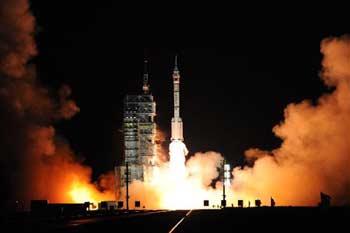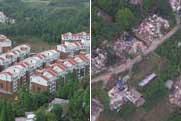China
China´s manned spacecraft Shenzhou-7 blasts off on space walk mission
Source: CCTV.com | 09-25-2008 21:34
Special Report: Shenzhou-7 Manned Space FlightJIUQUAN, Gansu, Sept. 25 (Xinhua) -- China launched its third manned spacecraft on Thursday with three astronauts on board to attempt the country's first-ever space walk.
 |
| The Long-March II-F carrier rocket carrying the Shenzhou-7 spaceship blasts off from the launch pad at the Jiuquan Satellite Launch Center in northwest China's Gansu Province, on 21:10 p.m., Sept. 25, 2008. (Xinhua/Li Gang) |
The spaceship Shenzhou-7 blasted off on a Long March II-F carrier rocket from the Jiuquan Satellite Launch Center in the northwestern Gansu Province at 9:10 p.m. after a breathtaking countdown to another milestone on China's space journey.
Onboard pilots Zhai Zhigang, Liu Boming and Jing Haipeng are expected to orbit the earth for 4 days, when one of them will float out of the cabin about 343 kilometers above the earth.
When they make it, China will become the third country in the world who is able to conduct extra-vehicular activity in space following the former Soviet Union and the United States.
Chinese president Hu Jintao watched the historic moment at the launch center, joined by Chinese experts and other work staff.
Two taikonauts would enter the orbital module, where one would put on domestically-made spacesuit Feitian and leave the module to take back test samples loaded outside, said Zhou Jianping, chief designer of the country's manned space project.
The other would wear a Russian Orlan suit and stay in the depressurized cabin for support, said Zhou.
"We wish we could fly freely in space just like Feitian on the ancient Buddhist murals, so we gave this name to the homemade spacesuit," said Zhou.
Feitian, which literally means flying in the sky, is the name of a legendary Buddhist goddess.
Other tasks of the Shenzhou-7 crew include the release of a small monitoring satellite and a trial of the data relay of the satellite Tianlian-I.
The taikonauts, all 42 years old, are scheduled to land in the central region of north China's Inner Mongolia Autonomous Region in a re-entry module after their mission is completed.
Editor:Zhang Ning



